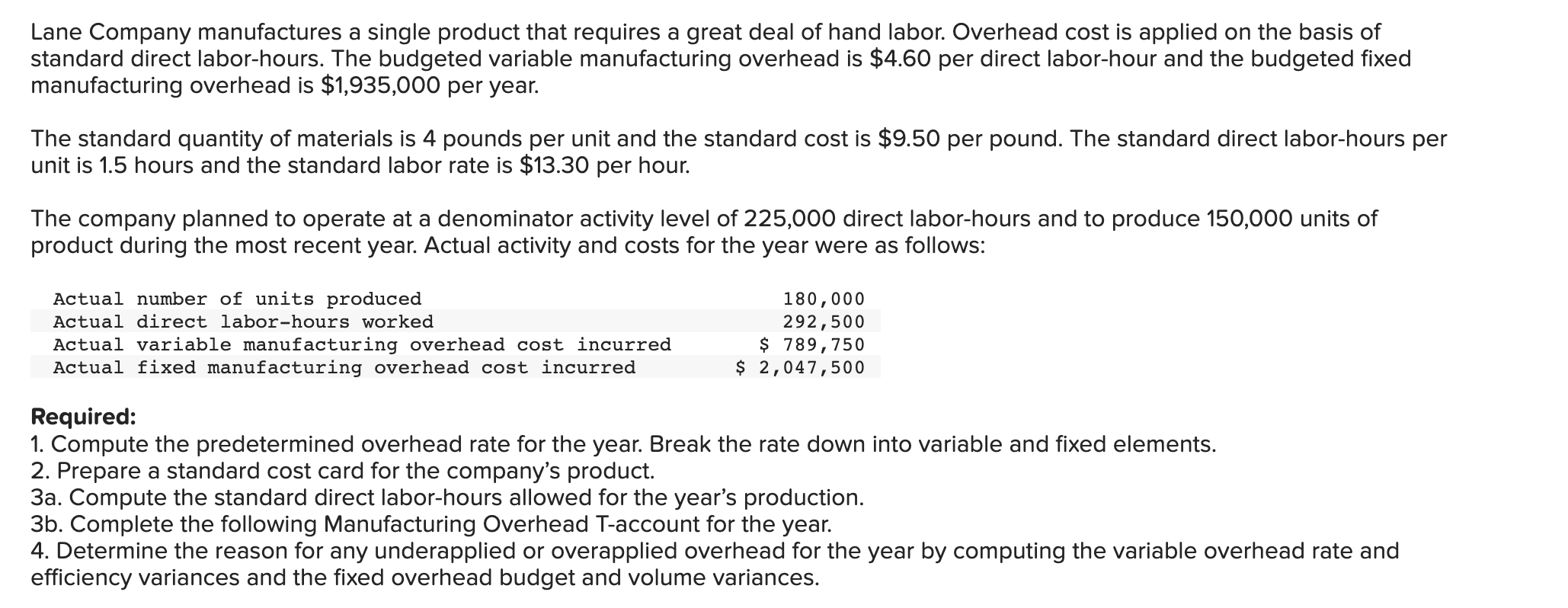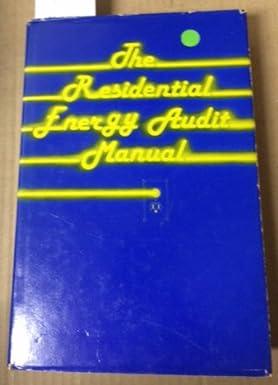Answered step by step
Verified Expert Solution
Question
1 Approved Answer
Compute the predetermined overhead rate for the year. Break the rate down into variable and fixed elements. (Round your answers to 2 decimal places.) Prepare




 Compute the predetermined overhead rate for the year. Break the rate down into variable and fixed elements. (Round your answers to 2 decimal places.) Prepare a standard cost card for the company's product. (Round your answers to 2 decimal places.) \begin{tabular}{|l|c|l|c|l|ll|} \hline Direct materials & & poundsat & & per pound & $0.00 \\ \hline Direct labor & & DLHs at & & per DLH & $0.00 \\ \hline Variable overhead & & DLHs at & & per DLH & $0.00 \\ \hline Fixed overhead & & DLHs at & & per DLH & $0.00 \\ \hline Standard cost per unit & & & & & $0.00 \\ \hline \end{tabular} Lane Company manufactures a single product that requires a great deal of hand labor. Overhead cost is applied on the basis of standard direct labor-hours. The budgeted variable manufacturing overhead is $4.60 per direct labor-hour and the budgeted fixed manufacturing overhead is $1,935,000 per year. The standard quantity of materials is 4 pounds per unit and the standard cost is $9.50 per pound. The standard direct labor-hours per unit is 1.5 hours and the standard labor rate is $13.30 per hour. The company planned to operate at a denominator activity level of 225,000 direct labor-hours and to produce 150,000 units of product during the most recent year. Actual activity and costs for the year were as follows: Required: 1. Compute the predetermined overhead rate for the year. Break the rate down into variable and fixed elements. 2. Prepare a standard cost card for the company's product. 3a. Compute the standard direct labor-hours allowed for the year's production. 3b. Complete the following Manufacturing Overhead T-account for the year. 4. Determine the reason for any underapplied or overapplied overhead for the year by computing the variable overhead rate and efficiency variances and the fixed overhead budget and volume variances. Complete the following Manufacturing Overhead T-account for the year. Determine the reason for any underapplied or overapplied overhead for the year by computing the variable overhead rate and efficiency variances and the fixed overhead budget and volume variances. (Indicate the effect of each variance by selecting "F" for favorable, "U" for unfavorable, and "None" for no effect (i.e., zero variance). Input all amounts as positive values.)
Compute the predetermined overhead rate for the year. Break the rate down into variable and fixed elements. (Round your answers to 2 decimal places.) Prepare a standard cost card for the company's product. (Round your answers to 2 decimal places.) \begin{tabular}{|l|c|l|c|l|ll|} \hline Direct materials & & poundsat & & per pound & $0.00 \\ \hline Direct labor & & DLHs at & & per DLH & $0.00 \\ \hline Variable overhead & & DLHs at & & per DLH & $0.00 \\ \hline Fixed overhead & & DLHs at & & per DLH & $0.00 \\ \hline Standard cost per unit & & & & & $0.00 \\ \hline \end{tabular} Lane Company manufactures a single product that requires a great deal of hand labor. Overhead cost is applied on the basis of standard direct labor-hours. The budgeted variable manufacturing overhead is $4.60 per direct labor-hour and the budgeted fixed manufacturing overhead is $1,935,000 per year. The standard quantity of materials is 4 pounds per unit and the standard cost is $9.50 per pound. The standard direct labor-hours per unit is 1.5 hours and the standard labor rate is $13.30 per hour. The company planned to operate at a denominator activity level of 225,000 direct labor-hours and to produce 150,000 units of product during the most recent year. Actual activity and costs for the year were as follows: Required: 1. Compute the predetermined overhead rate for the year. Break the rate down into variable and fixed elements. 2. Prepare a standard cost card for the company's product. 3a. Compute the standard direct labor-hours allowed for the year's production. 3b. Complete the following Manufacturing Overhead T-account for the year. 4. Determine the reason for any underapplied or overapplied overhead for the year by computing the variable overhead rate and efficiency variances and the fixed overhead budget and volume variances. Complete the following Manufacturing Overhead T-account for the year. Determine the reason for any underapplied or overapplied overhead for the year by computing the variable overhead rate and efficiency variances and the fixed overhead budget and volume variances. (Indicate the effect of each variance by selecting "F" for favorable, "U" for unfavorable, and "None" for no effect (i.e., zero variance). Input all amounts as positive values.) Step by Step Solution
There are 3 Steps involved in it
Step: 1

Get Instant Access to Expert-Tailored Solutions
See step-by-step solutions with expert insights and AI powered tools for academic success
Step: 2

Step: 3

Ace Your Homework with AI
Get the answers you need in no time with our AI-driven, step-by-step assistance
Get Started


